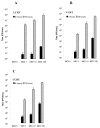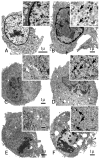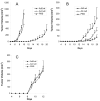Immunocompetent syngeneic cotton rat tumor models for the assessment of replication-competent oncolytic adenovirus
- PMID: 17727912
- PMCID: PMC2104792
- DOI: 10.1016/j.virol.2007.07.022
Immunocompetent syngeneic cotton rat tumor models for the assessment of replication-competent oncolytic adenovirus
Abstract
Oncolytic adenoviruses as a treatment for cancer have demonstrated limited clinical activity. Contributing to this may be the relevance of preclinical animal models used to study these agents. Syngeneic mouse tumor models are generally non-permissive for adenoviral replication, whereas human tumor xenograft models exhibit attenuated immune responses to the vector. The cotton rat (Sigmodon hispidus) is susceptible to human adenovirus infection, permissive for viral replication and exhibits similar inflammatory pathology to humans with adenovirus replicating in the lungs, respiratory passages and cornea. We evaluated three transplantable tumorigenic cotton rat cell lines, CCRT, LCRT and VCRT as models for the study of oncolytic adenoviruses. All three cells lines were readily infected with adenovirus type-5-based vectors and exhibited high levels of transgene expression. The cell lines supported viral replication demonstrated by the induction of cytopathogenic effect (CPE) in tissue culture, increase in virus particle numbers and assembly of virions seen on transmission electron microscopy. In vivo, LCRT and VCRT tumors demonstrated delayed growth after injection with replicating adenovirus. No in vivo antitumor activity was seen in CCRT tumors despite in vitro oncolysis. Adenovirus was also rapidly cleared from the CCRT tumors compared to LCRT and VCRT tumors. The effect observed with the different cotton rat tumor cell lines mimics the variable results of human clinical trials highlighting the potential relevance of this model for assessing the activity and toxicity of oncolytic adenoviruses.
Figures







Similar articles
-
Expression of human CD46 and trans-complementation by murine adenovirus 1 fails to allow productive infection by a group B oncolytic adenovirus in murine cancer cells.J Immunother Cancer. 2018 Jun 13;6(1):55. doi: 10.1186/s40425-018-0350-x. J Immunother Cancer. 2018. PMID: 29898782 Free PMC article.
-
Cotton rat tumor model for the evaluation of oncolytic adenoviruses.Hum Gene Ther. 2005 Jan;16(1):139-46. doi: 10.1089/hum.2005.16.139. Hum Gene Ther. 2005. PMID: 15703497
-
Immunocompetent, semi-permissive cotton rat tumor model for the evaluation of oncolytic adenoviruses.Methods Mol Med. 2007;130:157-68. doi: 10.1385/1-59745-166-5:157. Methods Mol Med. 2007. PMID: 17401171
-
Chapter three--Syrian hamster as an animal model to study oncolytic adenoviruses and to evaluate the efficacy of antiviral compounds.Adv Cancer Res. 2012;115:69-92. doi: 10.1016/B978-0-12-398342-8.00003-3. Adv Cancer Res. 2012. PMID: 23021242 Review.
-
Real-Time Fluorescence Image-Guided Oncolytic Virotherapy for Precise Cancer Treatment.Int J Mol Sci. 2021 Jan 17;22(2):879. doi: 10.3390/ijms22020879. Int J Mol Sci. 2021. PMID: 33477279 Free PMC article. Review.
Cited by
-
Chorioallantoic Membrane Tumor Model for Evaluating Oncolytic Viruses.Hum Gene Ther. 2020 Oct;31(19-20):1100-1113. doi: 10.1089/hum.2020.045. Epub 2020 Aug 17. Hum Gene Ther. 2020. PMID: 32552215 Free PMC article.
-
Expression of human CD46 and trans-complementation by murine adenovirus 1 fails to allow productive infection by a group B oncolytic adenovirus in murine cancer cells.J Immunother Cancer. 2018 Jun 13;6(1):55. doi: 10.1186/s40425-018-0350-x. J Immunother Cancer. 2018. PMID: 29898782 Free PMC article.
-
An Oncolytic Adenovirus Vector Expressing p14 FAST Protein Induces Widespread Syncytium Formation and Reduces Tumor Growth Rate In Vivo.Mol Ther Oncolytics. 2019 May 15;14:107-120. doi: 10.1016/j.omto.2019.05.001. eCollection 2019 Sep 27. Mol Ther Oncolytics. 2019. PMID: 31193718 Free PMC article.
-
Rodents Versus Pig Model for Assessing the Performance of Serotype Chimeric Ad5/3 Oncolytic Adenoviruses.Cancers (Basel). 2019 Feb 8;11(2):198. doi: 10.3390/cancers11020198. Cancers (Basel). 2019. PMID: 30744019 Free PMC article.
-
Armed replicating adenoviruses for cancer virotherapy.Cancer Gene Ther. 2009 Jun;16(6):473-88. doi: 10.1038/cgt.2009.3. Epub 2009 Feb 6. Cancer Gene Ther. 2009. PMID: 19197323 Free PMC article. Review.
References
-
- Benjamin R, Helman L, Meyers P, Reaman G. A phase III dose escalation and activity study of intravenous injections of OCaP1 for subjects with refractory osteosarcoma metastatic to lung. Hum Gene Ther. 2001;12:1591–1593. - PubMed
-
- Bergelson JM, Cunningham JA, Droguett G, Kurt-Jones EA, Krithivas A, Hong JS, Horwitz MS, Crowell RL, Finberg RW. Isolation of a common receptor for Coxsackie B viruses and adenoviruses 2 and 5. Science. 1997;275:1320–3. - PubMed
-
- Bischoff JR, Kirn DH, Williams A, Heise C, Horn S, Muna M, Ng L, Nye JA, Sampson-Johannes A, Fattaey A, McCormick F. An adenovirus mutant that replicates selectively in p53-deficient human tumor cells. Science. 1996;274:373–376. - PubMed
-
- Dethlefsen LA, Prewitt JM, Mendelsohn ML. Analysis of tumor growth curves. J Natl Cancer Inst. 1968;40:389–405. - PubMed
-
- DeWeese TL, van der Poel H, Li S, Mikhak B, Drew R, Goemann M, Hamper U, DeJong R, Detorie N, Rodriguez R, Haulk T, DeMarzo AM, Piantadosi S, Yu DC, Chen Y, Henderson DR, Carducci MA, Nelson WG, Simons JW. A phase I trial of CV706, a replication-competent, PSA selective oncolytic adenovirus, for the treatment of locally recurrent prostate cancer following radiation therapy. Cancer Res. 2001;61:7464–7472. - PubMed
Publication types
MeSH terms
Grants and funding
LinkOut - more resources
Full Text Sources
Research Materials
Miscellaneous

